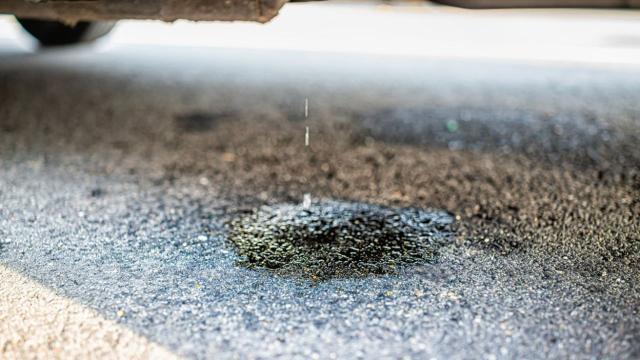Have you ever noticed iridescent rainbow stains on your driveway after it’s rained? What you’re seeing is the thin film interference principle at work, and a sign that someone’s car is leaking. But before you can address the root cause of the dripping, you need to figure out where it’s coming from, and what it is. One of the simplest ways to do that involves a large piece of cardboard and some detective work. I enlisted the help of two mechanics—Jason Farrell, an ASE certified master technician and the editor of Mechanic’s Diary and John Lim, a mechanic and the owner of JB Motor Works—who walked me through the steps of the cardboard test, and how to identify the leaking fluid.
How to use cardboard to identify car leaks
While the cardboard test is pretty straightforward, here are a few things to know that will help you get the most out of the process.
The set-up
Here’s what to do:
- Park: When you’ve finished driving for the day, “try to park on a flat surface to prevent the fluids from running off the cardboard,” says Lim.
- Wait: As a safety precaution, Farrell recommends waiting for the engine to cool down before getting started.
- Put down the paper: Place a large, light-colored piece of cardboard underneath the car. “Make sure the cardboard extends beyond the width of your vehicle,” Lim tells me. “If possible, use a large piece that can cover the area from the front bumper to the back.” Farrell recommends using using heavyweight cardboard.
Most people aren’t going to have car-sized pieces of white cardboard sitting around, so you may need to improvise. You could:-Tape several pieces of cardboard together—placing the tape on the underside only, if possible.-Glue or tape pieces of white paper on top of the cardboard.-Use white butcher paper (the kind that comes in a roll) and tape or weigh down the perimeter so it stays in place.-Use a light-colored tarp or old sheet. - Wait some more: Leave everything in place overnight.
The identification
Check the cardboard (or sheet, or butcher paper, etc.) the following day. “The stained cardboard tells quite a story,” says Farrell. More specifically, it will provide two pieces of information: what fluid is leaking, and where it’s leaking from.
It’s usually easier to try to identify the source of the leak first, while the cardboard is still in place.
“You need to trace the drips or stains on the cardboard back to the car,” Lim explains. “The position of the stain on the cardboard should give you a rough idea of where to start looking. However, keep in mind that fluids can drip off one part, hit another, and then fall to the ground, so the leak may not be directly above the stain.”
Farrell suggests using a flashlight to illuminate the undercarriage while tracing the leaks, and taking photos of the position and patterns of the stains while the cardboard is still under the car, and once it’s out.
Once you pull the cardboard or sheet out from under the car, it’s time to take a closer look at the stains.
The fluids
“When reviewing cardboard stains, location, color, smell, and consistency all provide clues to the source,” Farrell explains. “For example, oily spots dripping straight down likely come from the oil pan or filter areas. Greenish liquid pooling near the front signals coolant from the radiator, hoses, or water pump. Brake fluid may eat through the cardboard, indicating a leak higher up around calipers or brake lines.”
Here are some other tips for identifying various fluids from Farrell and Lim:
- Engine oil generally appears dark brown or black, feels slick, and burns the nose.
- Transmission fluid is usually red or green and slippery.
- Coolant can be pink, green, or yellow, feels slimy, and smells sweet.
- Power steering fluid is clear to light brown, and has a burnt-marshmallow smell.
- Brake fluid is clear to light brown, and feels oily but not slick.
If it looks like you have multiple leaks, Farrell recommends troubleshooting in order of difficulty. “Always start with the simplest leak possibilities before digging deeper, in case it’s an easy fix,” he says. “Catching problems early by ‘reading’ that cardboard could prevent thousands in repair bills down the road.”

Leave a Reply
You must be logged in to post a comment.